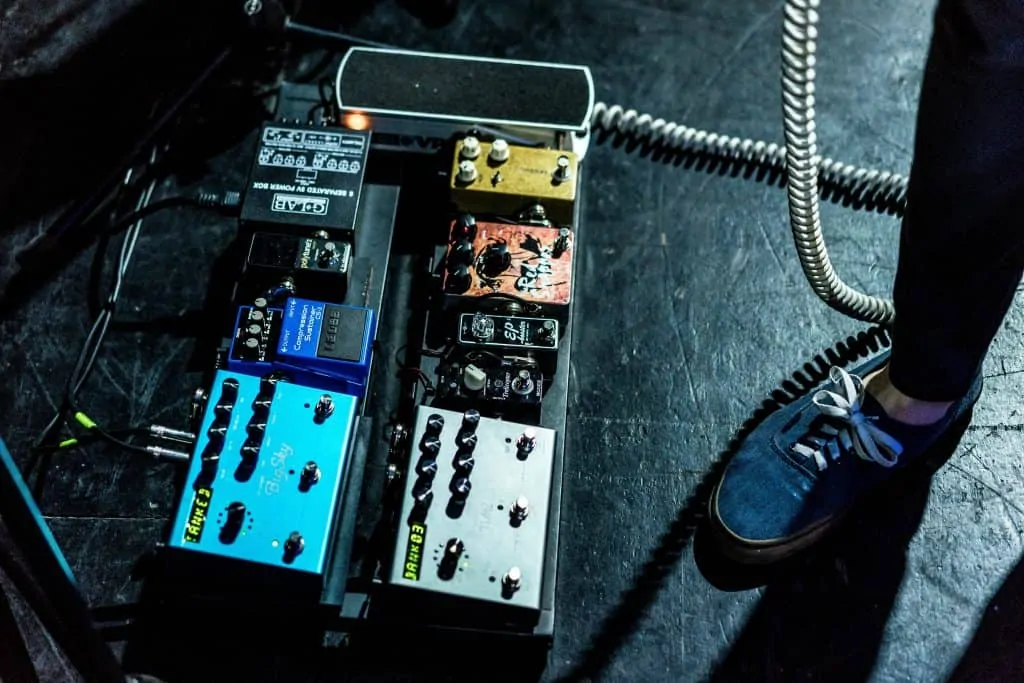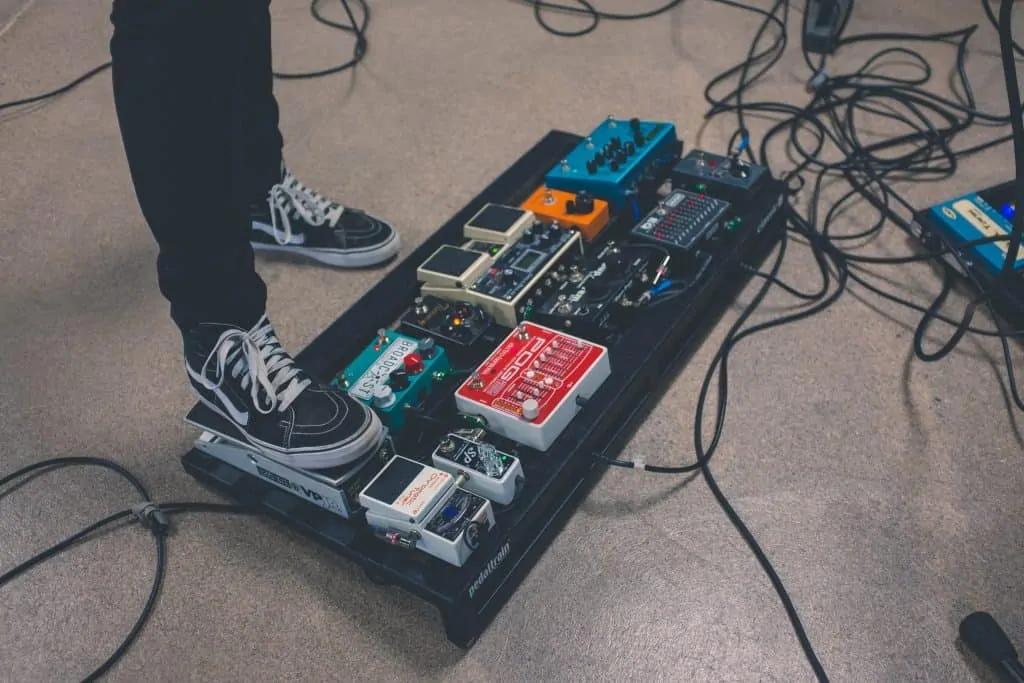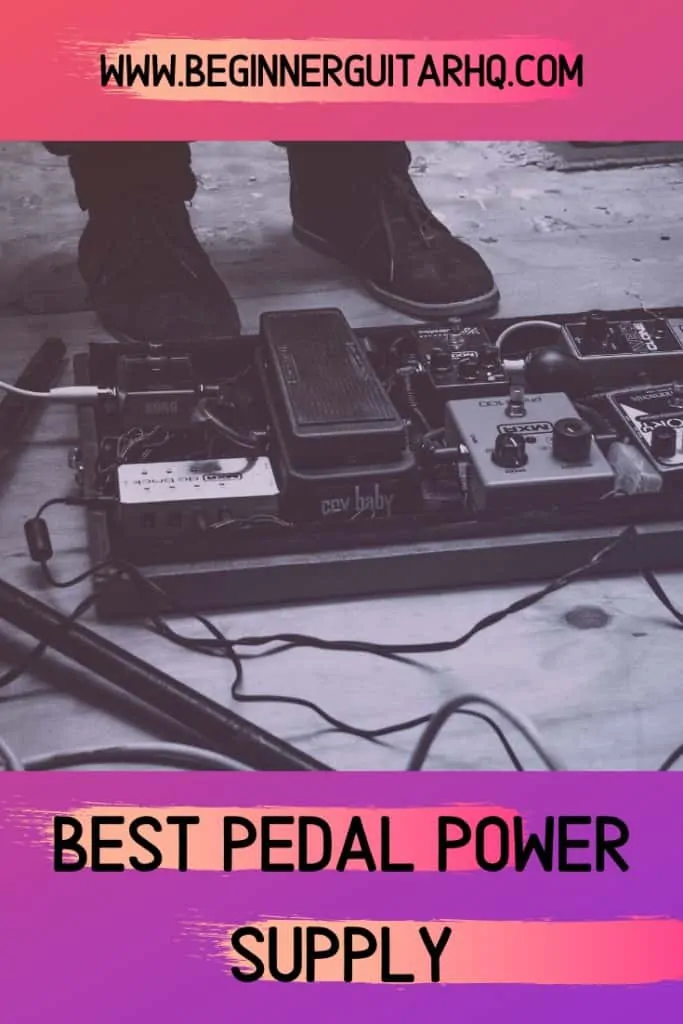If you’re building a pedalboard to house all your pedals then you’ll need a great power supply. A good quality pedal power supply can improve the tone and how clean the power hitting your pedals is.
Pedal power supplies come in all shapes and sizes. Some are small, some are large. Each model will power a different number of pedals, have a different number of outputs and a different feature set. It can be tough picking one for the first time but this guide will point you in the right direction.
Contents
Power Consumption
The first thing to consider is just how much power you need your pedal power supply to put out in order to power the pedalboard correctly. Every model you look at will have an output rating. Pedal power supply outputs are rated in mA (Milliamps). The number displayed on the pedal power supply specifications is the total number of mA that the unit can output.
To find out just how much power you need, first turn to your own pedal collection. On the bottom of each pedal you will see a sticker with information about polarity, voltage and current draw, If this information is not listed on the pedal, refer to the manual or manufacturer’s website.
Make a note of all the mA ratings for each pedal you plan to use and then total them up. This will give you the total amount of current draw for your entire signal chain.
Analogue pedals will have significantly lower current drawing demands than digital pedals. Things such as digital delays, digital reverbs and digital multi FX units are often larger current drawing pedals and this will need to be taken into consideration.

Voltage
It’s common to see pedals that need a 9v DC power supply and all pedal power supplies will be capable of delivering multiple instances of 9v DC. However, there are some pedals that have different voltage requirements but not all power supply manufacturers may be able to fulfil this need.
Some digital pedals may require 12v or 18v DC in order to run. You may also find that some overdrive pedals have the option to be run at a higher voltage to increase headroom. This means they will work on a standard 9v adapter, but can be pushed if needed.
More uncommon, is pedals that run on AC current rather than DC. Many overdrive pedals that have pre amp tubes built in, or amp simulator pedals may require AC to cope with the additional voltage needed to power the tube.
Take extra care with AC and DC as connecting the wrong current type or the wrong voltage rating can damage your pedal. Never connect a 9v pedal to an 18v supply as the double voltage will fry the pedal.
It is always a better bet to underpower something than overpower.
Isolated Power
Some pedal power supply units will be quoted as having isolated outputs. This can be an essential addition for certain pedals or sizeable pedalboards.
An isolated output is essential a power source separate from the others. Some power supplies may have for instance, 8 separate isolated outputs. They will, when run together, put out the total mA of the unit divided by the individual outputs.
If you have a 2000mA supply with 8 isolated outputs, each output will be able to put out a maximum of 250mA unless otherwise stated. Some companies will mix up various outputs and others will just evenly distribute across all outputs.
Some pedals, especially digital ones, like to see isolated power. Isolated power removes any unwanted hum or noise from the pedal chain and also goes a long way to prevent interference with the signal from dirty mains power.
Pedal Power Supply Units
Now that we’ve covered the specifics, let’s look at some units across a range of price points. Many of these units will be somewhat similar but will also offer a range of features to suit all needs and budgets.
Voodoo Lab Pedal Power 2 Plus
The Voodoo Lab Pedal Power is quite possibly one of the most recognisable pedal power supply units in the world. They are seen on pedalboards from Instagram players to touring professionals and for good reason.
This particular unit from Voodoo Lab offers 8 totally isolated outputs, delivering clean and quiet power to all your pedals.
The 8 outputs all offer a large current. The first 4 offer 100mA each, there is also a pair of higher current outputs rated at up to 250mA each and finally the two “sag” outputs each rated at 100mA each. Altogether that’s a total of 1100mA.
All the outputs on the Pedal Power 2 Plus are switchable from 9v to 12v with a series of dip switches located on the base of the unit. This is perfect for any high voltage pedals that need a little extra juice.
Outputs 5 and 6 are higher output than the others which makes them perfect for high current demanding modulation pedals such as Line 6’s Modulation range or other high current drawing pedals such as the Boss DD-20 Delay.
The final two outputs on the unit, 7 and 8, have built in sag controls. The output a current of 100mA like the rest of the unit but with the additional bonus of being able to adjust the voltage from 4v to 9v. Voodoo Lab say this is useful when using vintage transistor style fuzz pedals which are affected by voltage supply. This can emulate a dying battery. Many Dunlop Fuzz Face pedal users are known for chasing the dying battery tone. Eric Johnson is known for carrying a range of 9v batteries with a specific amount of charge left to get his Fuzz Face to sound the way he likes it.
MXR DC Brick
MXR are known in the pedal community as being one of the big players for producing high end, rock solid pedals that get seen on boards all over the world on big and small stages. Their entry into the pedal power supply world is a good bet for anyone looking for a small but powerful unit.
The DC Brick offers eight isolated 9v outputs as well as two 18v outputs for those high voltage pedals you may have. Each of the 9v outputs has an LED that lights up to let you know if there is a short on that circuit. This makes troubleshooting any power issues a breeze.
The DC Bricks is stated as being able to deliver 1200mA from it’s eight 9v ports with an average of 150mA per port, but the unit will work with any combination of current draws and adjust itself accordingly. If you plug in a pedal that needs 200mA, it will remove 50mA from another port.
The two 18v outputs are capable of delivering 800mA with an average of 400mA each. In total that gives you 2000mA of power to put out to your pedals.
1 Spot Pro CS12
The 1 Spot by Truetone is probably best known as one of the pedal industries leading daisy chain style supplies. Daisy chain pedal power supply systems work well, they function and they are very affordable, but they do not offer the same clean power as a good isolated unit.
The 1 Spot Pro is Truetone’s response to this demand. Here we have a 12 output power supply that would be capable of powering even the most demanding pedalboard setup.
This unit delivers a staggering 3000mA of power from it’s outputs which would satisfy even the most power hungry boards. That’s 1000mA more than the other leading competitors.
Across the units 12 outputs, we’ve got a great variation of options. There are four standard 9v outputs, two of which that deliver 250mA and two that deliver up to 500mA, a 9v output that delivers 100mA which is adjustable from 4-9v (Perfect for fuzz pedals). There is also four outputs that are switchable between 9v and 12v for those digital pedals that need a little extra.
That’s not all, the unit also has 2 outputs that work at 18v for those high headroom overdrive pedals to really shine and a 9v AC output that pushes out 800mA of power. There are not many other power bricks that offer any AC outlets, so this is a welcome addition. Nothing is off limits here.
Donner DP-4 Plus
The Donner DP-4 Plus is a more affordable pedal power supply that shares a striking similarity to another larger brand. How does it stack up?
The unit delivers 1200mA of power across 8 isolated outputs. For the price, this unit is packed with features that can’t be denied. Alongside it having four 9v outputs it has a pair of switchable outputs that allow you to choose between 9v or 12v on the first and 9v and 18v on the second and a pair of outputs with variable voltages from 4v to 9v.
No voltage option is left out here. This unit can cover everything you could possibly need. The DP-4 Plus is build around an internal transformer circuit with magnetic field shielding to prevent noise and short circuit/overcurrent protection built in. If there is a surge, the power supply will take the hit and not your precious, boutique pedal selection.
Each isolated output runs with its only short circuit protection so if there is a fault somewhere in the chain, only that particular power output will be affected meaning you can still use the unit.
Often power supply units that fit into a lower price point are basic and lack the features of their higher end competitors but the DP-4 ticks every box and still keeps the price affordable.
Caline CP-05
For the more budget conscious pedalboard lover, the Caline CP-05 offers a very attractive and functional pedal power supply at an entry level price. Does it provide entry level features? Certainly not.
The CP-05 from Caline is small but mighty. You can expect 1400mA of current split across 10 outputs that cover a range of voltages. Even though this unit is lower priced, it can still provide all your power needs.
The CP-05 has 7 standard 9v outputs each offering 100mA of current as well as an additional 9v output that offers 500mA of current. For anyone using pedals that require a higher voltage, we’ve also got a dedicated 12v output and a dedicated 18v output. The only downside here is that these are not switchable so if you don’t have pedals that need 12 or 18v then these outputs will go unused.
That’s a small price to pay for a unit that is so budget friendly and functional. Each channel has its own surge protection that works independently of each other channel so if one get’s hit but a surge, the remaining outputs are unaffected.
You even get a row of super bright blue LED lights on the front that give your pedalboard a lovely blue illuminated glow. Great on dark stages. These lights also indicated any surge or current issues on that particular channel.

Walrus Audio Aetos-8
For anyone looking for a small but powerful pedal power supply, the Walrus Audio Aeton-8 offers a lot of bang for it’s size. This tiny unit has eight 9v outputs offering a total of 1200mA of current and it’s small enough to be mounted underneath most pedalboard types.
The Aetos-8 offers total isolation with it’s internal, custom would transformer which Walrus Audio say offers the highest noise filtering and cleanest power. Housed in a solid, die cast case this power supply is ready for the road.
One thing that makes this particular unit very appealing is the additional 120v output socket on the side for conventional plugs. This means if you have a pedal that runs off a wall wart style plug, you can plug that into the Aetos-8 as if you’d plug into a regular socket. You could even charge your phone on stage!
Walrus take quality very serious and this is backed up with their 5 year warranty. 5 years is a long time to guarantee a product will work, especially a product that’s designed for stage use. This is certainly reflective of the level of quality you can expect.
Tom’sline Engineering APW-6
The APW-6 by Tom’sline is another affordable alternative to power up your pedalboard that offers some very interesting features for such a low price.
Firstly, it’s worth mentioning the overall current of this unit. We’ve got a jaw dropping 3500mA of current on offer here. Five of the outputs offer 9v with 100mA of current but there is also an additional 9v output offering up to 1A (1000mA) of current which will fulfil any current needs for any pedal.
There are also a pair of 12v outputs and an 18v output offering 1A of current draw. There is nothing this unit would turn it’s nose up at powering.
Toms’line include a range of cables with this unit so you can either connect single pedals to single outputs, or use the included daisy chain to power up to 5 pedals off one output. This is perfect for chaining together multiple pedals that don’t require much current. This option makes the power supply go a lot further.
Each output is isolated. When running a daisy chain you always extend the risk of a little noise but providing the pedals are low noise anyway, this shouldn’t be an issue.
They even kindly throw in a polarity reversal adapter as some pedals require reverse polarity to function correctly.
Choosing The Right One For You
Now that we’ve looked at a few options, its time for you to think about what you need. In summary, I’d recommend doing the following things:
- Make a list of how many pedals you plan on using
- Look at the mA and V requirements for each pedal – write them all down
- Total up the mA draw across all your pedals
- Look at power supplies with the relevant number of outputs and mA for what you need. Always allow some headroom on mA. If you need 1500mA, look at supplies that offer 2000mA so you aren’t running the unit at full power.
Don’t underestimate the importance of isolated outputs, especially if you are a gigging musician. Isolation will make a huge difference in this environment as many venues have different grades of clean power, some venues have very dirty power. Other stage elements can affect the noise on pedals too such as lighting or screens on stage. Isolation will keep things quiet.

